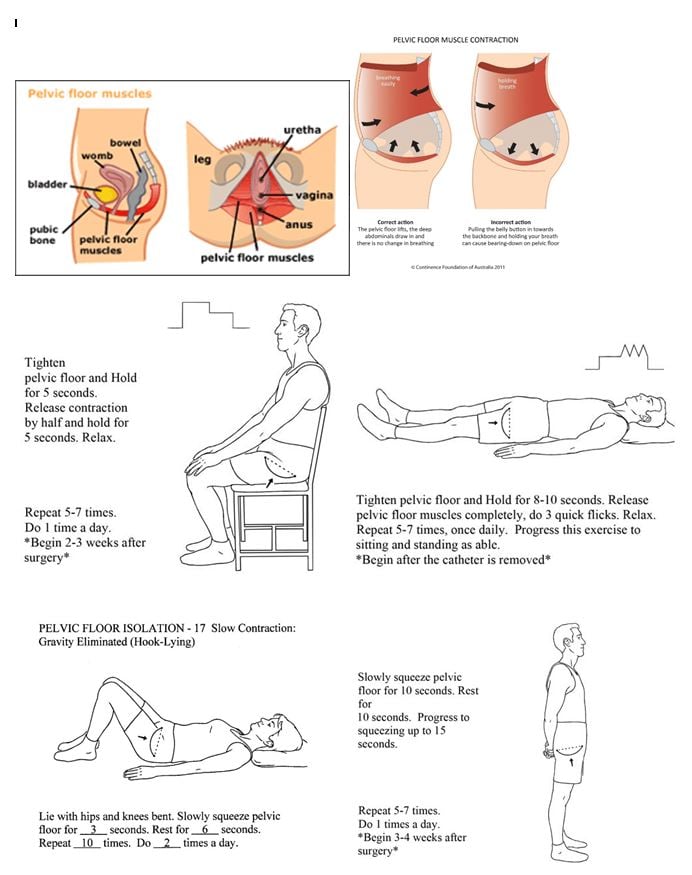Pelvic Floor Exercises in Females
What is the pelvic floor and why does it become weak?
The pelvic floor is a complex layer of muscles and ligaments which stretches like a hammock from the pubic bone at the front of your pelvis to the coccyx at the bottom of your spine
The pelvic floor has several functions:
- it supports your pelvic and abdominal organs, especially when you are standing or straining
- it helps the water pipe stay closed when you cough, sneeze or strain
- it is used to control leakage of wind or motions from your lower bowel
- The pelvic floor can be weakened by childbirth, prolonged straining to empty your bowels, lack of exercise and the menopause. It may also simply become weak as a result of ageing. A weak pelvic floor gives you less control so that you may leak when you exercise, lift, cough or sneeze.
How can exercising the pelvic floor muscles help?
Exercising the pelvic floor muscles can strengthen them so that they provide the support you need. This will improve your bladder control and improve, or even stop, leakage of urine. Like all other muscles in the body, the more you use and exercise them, the stronger they become and stay.
How do I find the pelvic floor muscles?
Sit comfortably with your knees slightly apart. Imagine that you are sitting on the toilet to pass urine and try to stop yourself from producing a stream of urine. You need to exercise the same muscles when at rest. Do not try to stop the urinary stream when you are actually passing water because it can cause problems with bladder emptying.
Try to tighten the muscles around your back passage and vagina, by lifting up inside as if you are trying to stop passing urine at the same time. Do not tense your abdomen, squeeze your legs together, tighten your buttocks or hold your breath.
How do I practise the exercises?
You need to develop two types of muscle activity, slow and fast.
Slow contractions
Do the exercises above and try to hold the pelvic floor tight for up to ten seconds. Rest for four seconds and then repeat the contraction as many times as you can, up to a maximum of ten
Quick contraction
Draw the pelvic floor rapidly upwards and hold this for one second. Repeat up to a maximum of ten times. This will protect you against sudden leakage during coughing, laughing or exercise
Aim to do one set of slow contractions followed by one set of fast contractions up to six times a day. Do not over-do it or the muscles will gettired. The exercises can be performed standing, sitting or lying down but you may find it easier at first to do them sitting down.
Other things that help
- Get into the habit of doing your exercises regularly and linking them to everyday activities e.g. do them after emptying your bladder, while answering the telephone, standing in a queue or whenever you turn on a tap
- Use the pelvic floor exercises to prevent leakage before you do anything which might make you leak; this way, your control will gradually improve
- Drink normally – six to eight cups (two litres) per day – avoiding caffeine and alcohol if you can
- Avoid going to the toilet “just in case”; go only when you feel that your bladder is full
- Watch your weight; extra weight puts more strain on your pelvic floor muscles and your bladder Avoid constipation. Straining can put excessive pressure on your bladder and bowels
- Pelvic floor exercises take three to six months to produce maximum benefit, but you should continue them for life to prevent problems recurring or worsening.
Pelvic floor exercises in males
What is the pelvic floor and why does it become weak?
The pelvic floor is a complex layer of muscles and ligaments which stretches like a hammock from the pubic bone at the front of your pelvis to the coccyx at the bottom your spine. A man’s pelvic floor supports his bladder and bowel. The urethra (waterpipe) and the rectum (back passage) pass through the pelvic floor muscles.
The pelvic floor has several functions:
- it supports your pelvic and abdominal organs, especially when you are standing or straining;
- it helps your urethra stay closed when you cough, sneeze or strain; and
- it controls leakage of wind or motions from your lower bowel.
The pelvic floor muscles can be weakened byoperations on your prostate gland, operations on other organs within the pelvis (e.g. the bowel), damage to the nerves of your pelvic floor muscles (by disease, injury, surgery or radiotherapy), repeated straining to empty your bowels, usually due to constipation, a chronic cough such as a smoker’s cough, chronic bronchitis or asthma, being overweight, lack of general fitnessand ageing
How do I contract the pelvic floor muscles?
Sit comfortably with your knees slightly apart. Imagine that you are sitting on the toilet to pass urine and try to stop yourself from producing a stream of urine. You need to exercise the same muscles when at rest. Do not try to stop the urinary stream when you are actually passing water because it can cause problems with bladder emptying. If your technique is correct, you will feel the base of your penis move upwards slightly towards your tummy.
Try to tighten the same muscles by lifting up inside as if you are trying to stop passing urine at the same time. Do not tense your abdomen, squeeze your legs together, tighten your buttocks or hold your breath.
How do I practise the exercises?
You need to develop two types of muscle activity, slow and fast.
Slow contractions
Do the exercises above and try to hold the pelvic floor tight for up to ten seconds. Rest for four seconds and then repeat the contraction as many times as you can, up to a maximum of ten
Quick contraction
Draw the pelvic floor rapidly upwards and hold this for one second. Repeat up to a maximum of ten times. This will protect you against sudden leakage during coughing, laughing or exercise
Aim to do one set of slow contractions followed by one set of fast contractions up to six times a day. Do not over-do it or the muscles will get tired. The exercises can be performed standing, sitting or lying down but you may find it easier at first to do them sitting down.
Other things that help
- Get into the habit of doing your exercises regularly and linking them to everyday activities e.g. do them after emptying your bladder, while answering the telephone, standing in a queue or whenever you turn on a tap
- Use the pelvic floor exercises to prevent leakage before you do anything which might make you leak; this way, your control will gradually improve
- Drink normally – six to eight cups (two litres) per day – avoiding caffeine and alcohol if you can
- Avoid going to the toilet “just in case”; go only when you feel that your bladder is full
- Watch your weight; extra weight puts more strain on your pelvic floor muscles and your bladder Avoid constipation. Straining can put excessive pressure on your bladder and bowels
- Pelvic floor exercises take three to six months to produce maximum benefit, but you should continue them for life to prevent problems recurring or worsening.









